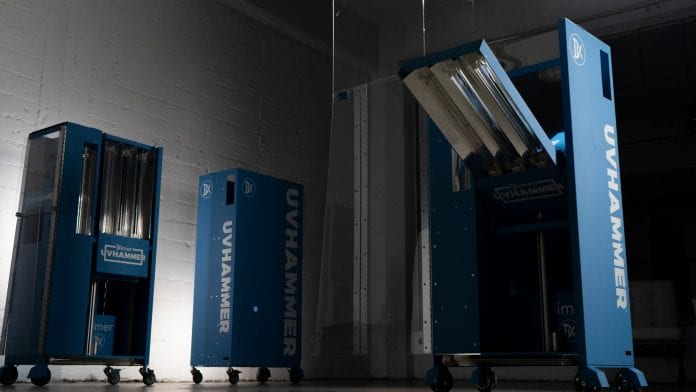
Ultraviolet light (UV) disinfection has been used in healthcare for decades and the COVID-19 pandemic has brought a renewed and accelerated emphasis to this technology’s incredible potential.
UV disinfection is most well established in heating, ventilation, and air conditioning (HVAC) and water purification systems, while UV surface disinfection has mostly struggled to break out of the healthcare space to date.
Partially driven by COVID-19, increased health expectations of public spaces have influenced demand for UVC disinfection machines – or ‘germ-killing robots’ – to be deployed outside of hospitals for the first time. The most notable new market event in the UVC space is Dimer’s and Honeywell’s strategic partnership for Dimer’s GermFalcon solution, now known as the Honeywell UV Treatment System. The Honeywell UV Treatment System has already been deployed on aircraft around the world, and will expand into other transportation vehicles as early as Q1 of 2021.
Dimer has been a leader in UVC innovation since 2012; Dr Arthur Kreitenberg, an orthopaedic surgeon, was inspired to start the company after attending his daughter’s club volleyball match during the 2009 H1N1 outbreak. It was there he noticed players were instructed not to shake hands in an effort to reduce the spread of the virus, yet all the players touched the same volleyball.
Inspired by the utilisation of UV disinfection deployed in his operating rooms, Dr Kreitenberg invented a device to rapidly disinfect sports balls, leveraging the same reliable germicidal lights with which he had become familiar in his medical practice. This invention quickly garnered attention and was later utilised in the 2012 Summer Olympics in London. From there Dr Kreitenberg quickly turned his attention to aeroplanes: the primary vector for the international spread of H1N1 and other germs.
Airlines and the spread of disease
With the arrival of the COVID-19 pandemic, more stakeholders than ever are drawing attention to inconsistent and unregulated airline cleaning protocols. Harvard University and other major institutions have published a robust body of literature correlating the spread of disease-causing pathogens with air travel. This has been seen with MERS, SARS, Ebola and now COVID-19; reminders that the natural barriers to the spread of disease, like mountains and oceans, have been rendered obsolete by commercial passenger travel.
The World Health Organization (WHO), International Air Transport Association (IATA), US Centers for Disease Control and Prevention (CDC), and International Civil Aviation Authority (ICAO) all recommend regular aircraft disinfection, but to date there are no mandates or regulations in place. Airlines prioritise serving the highest possible volume of flights per day, meaning they are incentivised to minimise turnaround time on the ground and cleaning protocols must be calibrated to fit into turnaround time.
As COVID-19 brought the commercial airline industry to a grinding halt, airlines quickly reached for common chemical cleaning solutions. The effectiveness of applying these solutions in a cabin interior is reliant on the execution of the product instructions. To apply chemical solutions properly requires diligent and copious application, which raises concern about the chemical’s effects on textiles, electronics, avionics and air filtration. In November 2020, the FAA released a warning to airlines about corrosive and potentially critical residual effects to the aircraft itself as a result of repeated heavy chemical application.
The Dimer/Honeywell partnership
Today, Dimer is most widely recognised for its GermFalcon solution for aircraft cabins: a device mirroring the design of an airline beverage cart, equipped with two mechanical wings which extend over the passenger seat backs and under the overhead bins like a puzzle piece. These wings, equipped with powerful UVC lamps, rapidly deliver proven doses of UVC light to all critical high-touch areas. With time and consistency being the industry’s most significant hurdles to proper cleaning protocols, a single member of the cleaning crew can consistently decontaminate high touch surfaces of a narrowbody aircraft, including galleys and lavatories, in a matter of minutes.
Offering a novel, chemical free approach to aircraft disinfection, the Honeywell UV Treatment System (formerly known as the Dimer GermFalcon) is beginning to land in transportation markets globally. The solution, referred to as a ‘potential game-changer’ by JetBlue COO Joanna Geraghty, is already making passengers safer on airlines around the world including Qatar Airways, JetBlue, Azul Airlines and Bulgarian Airlines, with more on the way.
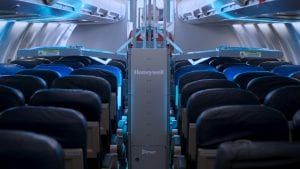
Introducing UVHammer: a UVC solution for any setting
With Honeywell driving the GermFalcon project for aerospace and transportation, Dimer is turning its attention to helping other organisations at the forefront of the pandemic with the rollout of the UVHammer solution.
The UVHammer leverages the same intellectual property as the GermFalcon, but is optimised for utility in any environment: a universal application delivering medical-grade disinfection in seconds.
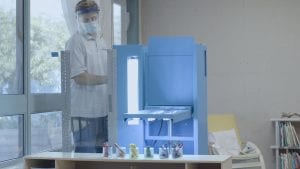
Understanding the UVC landscape
The current landscape of traditional UV systems features a commoditised selection of UVC lamps in the shape of a vertical tower, all at an exorbitant price tag. Before Dimer’s breakthrough designs, this vertical tower format was ubiquitous in the market. Early UVC machines do not consider the fundamental physical properties of light and are plagued with inefficiencies and design flaws that make them impractical to deploy outside of a healthcare setting.
These physical limitations that affect basic efficacy of UVC germicidal irradiation can be categorised into the following key concepts:
- Distance
- Line of sight
- Angle of incidence
Distance
The distance from a light source to a target surface is a critical factor in determining the time required to achieve desired UV dosages. The dosage of light delivered follows the inverse square law, meaning the germicidal efficacy of UVC light falls off exponentially as the light source is positioned further from the target surface. For example, a light that is three times as far away will require roughly nine times the exposure time to deliver an equivalent dosage. Stationary UV systems are typically positioned in one area of the room per ‘cycle,’ and standard operation calls for multiple cycles – each one typically five to 15 minutes long. Multiple cycles and positions are recommended to allow for increased UV doses, but these operational principles alone cannot overcome the exponential decay of UVC effectiveness over distance.
UV exposure has been shown to cause discolouration of some target surfaces. The cause of surface discolouration is repeated and lengthy cycle times, which are necessary when stationary light sources target faraway surfaces. Stationary UV systems are calibrated to operate cycles long enough to deliver desired dosages to the targets which are furthest away, but this method leads to those systems delivering doses greater than is necessary to nearby targets. Over time, the treated surface materials may change noticeably.
Thanks to its targeted surface-by-surface application, Dimer’s UVHammer delivers required proven dosages every time and consistently across each surface. In addition to reducing time requirements, minimising distance and reducing cycle times prevents the likelihood of oversaturating – and potentially damaging – any target surface.
Line of sight and shadows
The principal limitation of UVC germicidal irradiation is the requirement for direct exposure, or line of sight, between the UVC light source and the target. On a macro scale, problematic shadows are caused by different objects (furniture, curtains, IV drips, etc) intercepting the path of the light from source to target. On a microscopic scale, these micro-shadows are caused by the microscopic divots in material textures. In both cases, a moveable and adjustable UVC lamp is necessary to ensure all target areas are directly exposed to UVC light.
In a 50m2 operating room setting, a traditional UVC system would require a five-minute to 15-minute cycle in at least three locations, while furniture and other items are rearranged between cycles in an attempt to reduce shadowed surfaces.
Dimer’s mobility is multidimensional compared to first-generation UVC solutions. An adjustable wing extends from a mobile base, operated at a walking pace to quickly deliver proven germicidal dosages to every surface in any environment. A Nationally Recognised Testing Laboratory (NRTL) has proven Dimer’s ability to disinfect a 50m2 operating room in less than five minutes.
Angle of incidence (canyon wall effect)
Even the smoothest of surfaces feature microscopic divots. This texture provides pathogens with ‘hiding’ places from a fixed UV light source by shadowing the pathogens from the lamp’s line of sight. This phenomenon, known as the ‘canyon wall effect’, was first discovered by Dimer’s very own Dr Kreitenberg.
Surfaces like floors, chairs or countertops will always be covered in these microscopic textures. It is therefore particularly important to understand the canyon wall effect in the context of how UV lamp orientation on textured surfaces affects the kill rate of contaminants (see illustration below showing why a vertical UV source is not compatible with effective treatment of horizontal surfaces).
To be most effective, UVC lights must be angled so that the lamps are parallel to the target surface, ensuring perpendicular and complete exposure of all lingering particles. Dimer’s novel intellectual property ensures Dimer products are the only mobile solutions able to achieve this improved functionality. It is worth noting that most high contamination surfaces are horizontal. According to a Georgia Institute of Technology study (Jaffe, 2020), airborne bacteria are 98% more likely to land on a horizontal rather than a vertical surface.
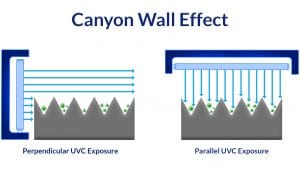
The advantages of operator-driven mobility
While autonomous robots are typically marketed as an optimal solution for creating workflow efficiencies in cleaning protocols, they tend to create increased complexity and associated labour requirements.
These robots are not only expensive, but actually generate additional burden. Each ‘autonomous’ unit requires a human supervisor to open and close doors to access each area. A software engineer must be available to code the robot’s unique route in each room, each time the room layout changes even slightly. Lastly, these automated solutions tend to have short battery life and long charging times – equating to significant downtime throughout the day.
Dimer’s unique, operator driven design recognises these pitfalls and instead offers a human solution, replacing extra steps and pricey skilled labour with a solution that enables your existing facility staff to disinfect all day, every day, after a quick and simple safety training course.
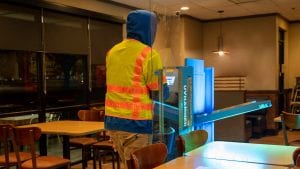
Designed with safety in mind
UV radiation can cause skin and eye irritation. While UVC can be dangerous if not properly utilised, exposure concerns are easily mitigated with proper protection and protocols.
It is important to understand that UVC light has poor penetrative properties: this means that it is unable to travel through most materials like glass or hard plastics. Dimer uses this to its advantage with its proprietary UVC-Impervious Shield which protects the operator from any traces of exposure. Extensive testing from an NRTL showed that 0.00% of UVC exposure reaches any point behind the UVHammer’s UVC Impervious Shield.
Additional safety measures are put into place to ensure the safety of others in the area, such as door stop alarms, door placards, and touch sensitive handles which instantly shut off the lamps if an operator’s hand is removed from the controls. Further, Dimer’s comprehensive certification course ensures operators are ready to safely and effectively operate the UVHammer before receiving their personal operator key code.
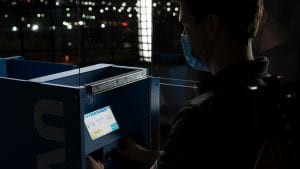
Preparing for the future
Since 2012, Dimer has set out to establish higher infection prevention standards in all public settings. With infectious disease prevention strategies becoming a major focus to global stakeholders at all levels – from customers to board executives, those who implement effective and intelligent health safety protocols today will be rewarded in the long term.
UVHammer is the first real application of UVC technology that can be easily integrated into any environment, leveraging the fastest, most effective disinfection methods available.
Reach out today to learn how Dimer’s UVHammer can improve your organisation’s safety protocols – keeping you safe now, and for years to come.
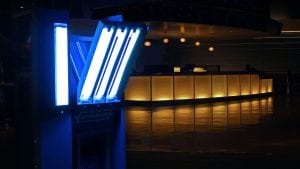
Elliot Kreitenberg
Co-founder & President
Max Solomon
VP of Marketing & Communications
Dimer LLC
info@dimeruv.com
www.dimeruv.com
This article is from issue 16 of Health Europa. Click here to get your free subscription today.










